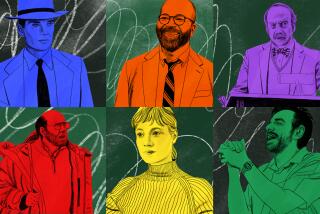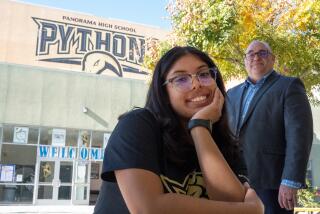Science Conference : Simple and Sophisticated Displays Lure Teachers
- Share via
The world of science Saturday spanned Dan Parker’s $10,000 closed-circuit video microscopy system and Sam Wida’s $1 magnet.
Caught in the middle were 600 Los Angeles-area science teachers attending an educational conference at North Hollywood High School.
Parker sells a sophisticated television system mounted in its own rolling cabinet. He had set it up at one end of a display room at the conference. Its camera was focused through a microscope and hooked to a large TV screen showing an enlarged close-up of frog tissue.
Wida sells magnets and other small school supplies. His modest magnet display was set up on a folding table at the other end of the room. To attract attention, he sprinkled iron filings on one of his magnets and projected its shadow on the wall with an overhead projector.
Hands-On Teaching
Parker adjusted an electronic arrow on his TV screen. “This is the overhead projector of the future,” he said. “It’s not that kids pay more attention to TV, it’s just that classrooms are full of things that are small that they want to see.”
Wida fiddled with the iron filings to change their shadowy shape. “Naturally we think hands-on experience is a better way of teaching the basics,” he said. “If you can do it, you develop an interest in it. A TV can catch a kid’s attention, but things you can touch are what kids like.”
Both displays attracted knots of onlookers all day long as teachers circulated between lectures and discussions presented by the convention’s sponsor, the Greater Los Angeles Teacher’ Science Assn. Along with the hundreds of teaching aids available for sale were things that were not, like a one-of-a-kind computerized “design your own jet fighter” display loaned by the Northrop Corp.
“The technology that goes into something like microscopy is awesome,” said Bob Demetrion, a junior high school teacher from Panorama City. “We have some old microscopes that you can just barely see organisms through. The kids I teach would go absolutely nuts over a video system like that.”
Demetrion said students have become more mature and media-savvy in recent years but that the teaching system hasn’t always kept pace. “Kids drop out because it’s simply boring,” he said.
But Altadena elementary teacher Robin Williams said that things like traditional microscopes--and magnets--are more effective than video displays.
“They are exposed to computers and TVs. Why should kids sit there in class and watch another screen? I think most teachers in my school are realizing you have to do more hands-on teaching. For my sixth-graders, use of a microscope is exciting,” Williams said.
In the end, classroom technique can be influenced as much by funding as by philosophy, said Arthur Langton, a veteran junior high school science teacher from Canoga Park.
“Hands-on is very important, but you need a balance. Some kid always has to sit in the back of the class where it’s hard to see,” Langton said. But whether a teacher wants to buy 30 student desk microscopes or one classroom micro-video system, “supply and money is very scarce.”
Alex Bailian, founder and president-elect of the science association, said he hopes Saturday’s equipment demonstrations and curricula discussions stimulate teachers in the classroom--and in school district board rooms.
He said state lottery money and special grants supplement conventional classroom funding. “Teachers are learning their way around to where the money is,” he said.







